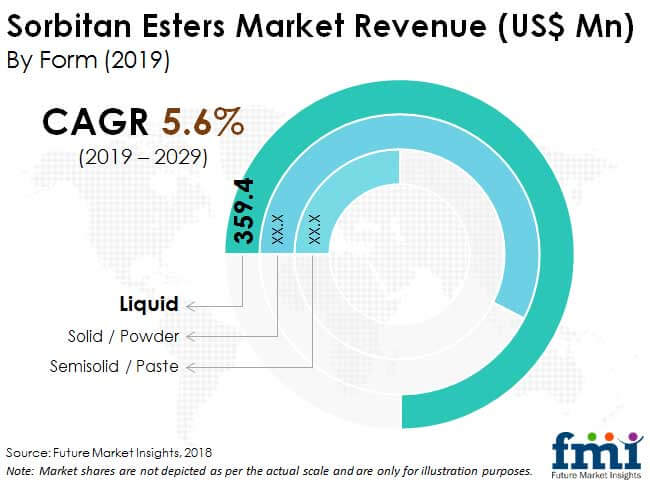
Global sorbitan esters consumption roughly accounted for the revenue of US$ 720 Mn in 2018. According to FMI’s analysis, the sorbitan esters market value will see a healthy 5.6% CAGR during 2019-2029.
Rising awareness regarding harmful effects of chemicals in food and personal care products is shifting consumers’ preference towards natural ingredients and organically sourced food products. This is compelling manufacturers to launch clean label products in the market, which in turn is boosting sales of sorbitan esters.
With the earliest recorded commercial use of egg yolk and beeswax as emulsifiers during food production, manufacturers have been shifted away from these conventional emulsifying agents due to their short-term stability. Sorbitan esters, the most widely used emulsifier across the food and beverages industry, also find extensive applicability in pharmaceutical, cosmetic, textile, leather, and metalworking industries.
Request a report sample to obtain authentic analysis and comprehensive market insights at- https://www.futuremarketinsights.com/reports/sample/rep-gb-2161
“Increasing demand for sorbitan esters from the pharmaceutical, textile leather, and agriculture industries, coupled with new products launches by manufacturers to meet clean labeling criteria will continue augmenting growth of the global sorbitan esters market over the forecast period,” says an FMI analyst.
Sorbitan Esters Surpassing Traditional Applications in F&B Industry
In the food and beverages industry, sorbitan esters are used as food additives with an excellent functionality of a stabilizer and an emulsifier, which are typically used in products such as ice creams, baked goods, chocolates, and dairy products. Traditionally, food emulsifiers are used in food products such as margarines, and ice creams among others.
Moreover, sorbitan esters have been witnessing strong traction among regional food regimes such as Japanese cuisines including tofu and minced fish products. The expanse of F&B industry, particularly within developing regional markets, is driving demand growth of sorbitan esters. Countries such as China, India, and Brazil continue to register constantly rising demand for packaged foods and ready-to-eat products, which is in turn pushing consumption levels of sorbitan esters.
Sorbitan esters, also known as Span, have been approved by the FDA, and they have gained GRAS (generally recognized as safe) status for theirs use in food and beverage products, cosmetics, and pharmaceuticals among others. Most sorbitan esters in the market possess the functionality of a surfactant or an emulsifying agent. The report opines that sorbitan esters will encounter lucrative opportunities within agrochemicals sector, in the years to come, further driving revenue growth of the sorbitan esters market.
Discover more about report analysis with figures and data tables, along with the table of contents. Ask for Analyst- https://www.futuremarketinsights.com/ask-question/rep-gb-2161
Cosmetic Industry’s Expansion Boosting Sorbitan Esters Consumption Level
The use of cosmetic products has increased at a rapid rate over the last few years, owing to the emergence of various key players in the global market and strategic marketing of these players to attract more consumers. Sorbitan esters are used in cosmetic products as surfactants and solubilizers, in addition to a wide range of commonly sold products such as skin care products, cleansers, makeup products, and moisturizers.
Sorbitan esters are also used in cosmetic products as wetting agents and dispersants, especially in color cosmetics and sun care products. Currently, in the cosmetic industry, skin care products are enjoying high demand from all demographic groups. Globally recognized brands such as Mac Cosmetics, Avon, Estée Lauder, L’Oreal, and Willa have firmed up their footprint in the Asian market, and several others have been investing efforts in market entry within the Asian landscape.
In line with evolving consumer demand for an innovative cosmetic products range, a number of manufacturers are augmenting investments in product R&D and innovation, followed by new product launches. Improving availability of international brands, strongly backed by growing awareness and surging spending power of consumers, is significantly contributing to sales of cosmetics products – eventually translating into increased consumption of sorbitan esters.
Key Companies: Global Sorbitan Esters Market
FMI’s study has covered detailed strategic profiles of the key companies partaking in the competitive landscape of global sorbitan esters market. Some of the leading market players include Danisco, Merck KGaA, Oleon N.V., Ivanhoe industries, Inc., Vantage Specialty Chemicals, Inc., LEUNA-Tenside GmbH, Union Derivan, S.A., Sabo S.p.A., SEPPIC, Ethox Chemicals, LLC, Mosselman s.a., Lonza AG, Penta Manufacturing Company, Lasenor Emul, S.L.
Contact Sales for Further Assistance in Purchasing this Report- https://www.futuremarketinsights.com/checkout/2161
Global Sorbitan Esters Market: Segmentation
By Form:
- Liquid
- Solid
- Semisolid/Paste
By Product Type:
- Sorbitan Tristearate
- Sorbitan Monostearate
- Sorbitan Monooleate
- Sorbitan Trioleate
- Sorbitan Monopalmitate
- Sorbitan Monolaurate
- Sorbitan Sesquioleate
By End Use:
- Cosmetics and Personal Care Products
- Facial Care
- Body Care
- Food and Beverage Processing
- Confectionery
- Bakery
- Oils and Fats
- Non-alcoholic Beverages
- Alcoholic Beverages
- Soups, Sauces, and Gravies
- Pharmaceuticals
- Lubricants and Waxes
- Animal Nutrition and Pet Food
- Industrial (Polymers, Specialty Chemicals, Agrochemicals, etc.)
- Textiles
By Grade:
- Food Grade
- Industrial Grade
- Pharmaceutical Grade
By Region:
- North America
- Latin America
- Europe
- East Asia
- South Asia
- Middle East & Africa
- Oceania

